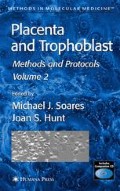Abstract
This chapter will describe the use of infection with Listeria monocytogenes, a Gram-positive intracellular bacterium, to study immunological responses in the placenta. This bacterium is chosen because it has a predilection for replication in the placenta. As such, it is a significant pathogen for pregnant women, being a major cause of fetal mortality and morbidity if appropriate public health precautions are not observed. Furthermore, this bacterium has been a major tool for studying innate immune responses and their transition to an acquired one, characterized by a Th1-type response. Details are given for the culture and maintenance of bacteria stocks, infection of mice, and analysis of the resultant infection. Such studies have revealed a unique pattern of immune responses in the placenta that, through the methods described, should reveal the strategies that the placenta uses to eradicate pathogens while not rejecting allogenic fetuses.
Access this chapter
Tax calculation will be finalised at checkout
Purchases are for personal use only
References
Barber, E. M. and Pollard, J. W. (2003) The uterine NK cell population requires IL-15 but these cells are not required for pregnancy nor the resolution of a Listeria monocytogenes infection. J. Immunol. 171, 37–46.
Cecchini, M. G., Dominguez, M. G., Mocci, S., et al. (1994) Role of colony stimulating factor-1 in the establishment and regulation of tissue macrophages during postnatal development of the mouse. Development 120, 1357–1372.
Cheers, C. and McKenzie, I. (1978) Resistance and susceptibility of mice to bacterial infection: genetics of listeriosis. Infect. Immun. 19, 755–762.
Gregory, S. H., Sagnimeni, A. J., and Wing, E. J. (1996) Bacteria in the bloodstream are trapped in the liver and killed by immigrating neutrophils. J. Immunol. 157, 2514–2520.
Guleria, I. and Pollard, J. W. (2001) Aberrant macrophage and neutrophil population dynamics and impaired Th1 response to Listeria monocytogenes in colonystimulating factor 1-deficient mice. Infect. Immun. 69, 1795–1807.
Guleria, I. and Pollard, J. W. (2000) The trophoblast is a component of the innate immune system during pregnancy. Nat. Med. 6, 589–593.
Kaufmann, S. H. E. (1993) Immunity to intracellular bacteria. Annu. Rev. Immunol. 11, 129–163.
Luo, Y., Lee, A., Shen, H., and Radice, G. L. (2003) Altering tissue tropism of Listeria monocytogenes by ectopically expressing human E-cadherin in transgenic mice. Microb. Pathog. 35, 57–62.
Mackler, A. M., Barber, E. M., Takikawa, O., and Pollard, J. W. (2003) Indoleamine 2,3-dioxygenase is regulated by IFN-gamma in the mouse placenta during Listeria monocytogenes infection. J. Immunol. 170, 823–830.
Medawar, P. B. (1953) Some Immunological and Endocrine Problems raised by evolution of viviparity in vertebrates. Symp. Soc. Exp. Biol. 7, 320–328.
Mellor, A. L. and Munn, D. H. (2000) Immunology at the maternal-fetal interface: lessons for T cell tolerance and suppression. Annu. Rev. Immunol. 18, 367–391.
Milon, G. (1997) Listeria monocytogenes in laboratory mice: a model of shortterm infectious and pathogenic processes controllable by regulated protective immune responses. Immunol. Rev. 158, 37–46.
Munn, D. H., Zhou, M., Attwood, J. T., et al. (1998) Prevention of allogeneic fetal rejection by tryptophan catabolism. Science 281, 1191–1193.
Pollard, J. W., Hunt, J. S., Wiktor-Jedrzejczak, W., and Stanley, E. R. (1991) A pregnancy defect in the osteopetrotic (op/op) mouse demonstrates the requirement for CSF-1 in female fertility. Dev. Biol. 148, 273–283.
Qazi, S. N., Rees, C. E., Mellits, K. H., and Hill, P. J. (2001) Development of gfp vectors for expression in Listeria monocytogenes and other low g+c Gram positive bacteria. Microb. Ecol. 41, 301–309.
Redline, R. W. and Lu, C. Y. (1987) Role of local immunosuppression in murine fetoplacental listeriosis. J. Clin. Invest. 79, 1234–1241.
Redline, R. W. and Lu, C. Y. (1988) Specific defects in the anti-listerial immune response in discrete regions of the murine uterus and placenta account for susceptibility to infection. J. Immunol. 140, 3947–3955.
Redline, R. W., McKay, D. B., Vazquez, M. A., Papaioannou, V. E., and Lu, C.Y. (1990) Macrophage functions are regulated by the substratum of murine decidual stromal cells. J. Clin. Invest. 85, 1951–1958.
Redline, R. W., Shea, C. M., Papaioannou, V. E., and Lu, C. Y. (1988) Defective anti-listerial responses in deciduoma of pseudopregnant mice. Am. J. Pathol. 133, 485–497.
Silver, H. M. (1998) Listeriosis during pregnancy. Obstet. Gynecol. Surv. 53, 737–740.
Unanue, E. R. (1997) Inter-relationship among macrophages, natural killer cells and neutrophils in early stages of Listeria resistance. Curr. Opin. Immunol. 9, 35–43.
Unanue, E. R. (1996) Macrophages, NK cells and neutrophils in the cytokine loop of Listeria resistance. Res. Immunol. 147, 499–505.
Author information
Authors and Affiliations
Editor information
Editors and Affiliations
Rights and permissions
Copyright information
© 2006 Humana Press Inc.
About this protocol
Cite this protocol
Barber, E.M., Guleria, I., Pollard, J.W. (2006). Infection With Listeria monocytogenes as a Probe for Placental Immunological Function. In: Soares, M.J., Hunt, J.S. (eds) Placenta and Trophoblast. Methods in Molecular Medicine™, vol 122. Humana Press. https://doi.org/10.1385/1-59259-989-3:435
Download citation
DOI: https://doi.org/10.1385/1-59259-989-3:435
Publisher Name: Humana Press
Print ISBN: 978-1-58829-608-5
Online ISBN: 978-1-59259-989-9
eBook Packages: Springer Protocols

